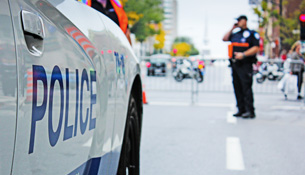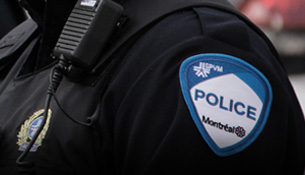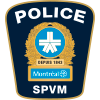
Unsafe driving
Various unsafe driving behaviours are observed on our roads and breach Highway Safety Code rules. They lead to many crashes and must be avoided. Here are some examples.
Failing to give way
Failing to give way is one of the most frequent causes of crashes involving vulnerable users. All road users are required to drive carefully and respectfully on public roadways especially with regard to vulnerable persons.
Here are some situations in which you are obliged to give way:
- When your vehicle is about to change lanes.
- At an intersection regulated by stop signs, you must give way to the vehicle that arrived before you, and also to pedestrians and cyclists.
- When you approach a pedestrian crossing, you must stop your vehicle and give way to pedestrians who are starting to cross or showing their intention to cross the pedestrian crossing.
- When you leave a private driveway, you must give way to all road users.
Fine: $200 + fees
Running a red light
When the traffic lights turn yellow, the driver must slow down and stop before the intersection, if it is possible to do so safely.
It is illegal to enter an intersection when the traffic lights are red. Running a red light is extremely dangerous and can have serious consequences.
Fine: $200 + fees (3 demerit points)
Failure to stop at a mandatory stop
The driver of a vehicle must come to a complete stop at a mandatory stop and give way to any vehicle entering the intersection before them. Before proceeding, they must let pedestrians and cyclists at the intersection cross.
Fine: $200 + fees (3 demerit points)
Tailgating
Keep a safe distance on the road between your vehicle and the vehicle in front of you, taking into account speed, traffic density, weather conditions and road conditions.
This safety distance will help you react appropriately to avoid a crash in the event of sudden braking or an unexpected manoeuvre.
Fine: $200 + fees (2 demerit points)
Road rage
Aggressiveness and impatience on the road can lead to risky and illegal manoeuvres, such as speeding and making illegal or dangerous lane changes that can cause crashes.
Fine: variable depending on the offence committed.
An offence that may compromise safety or lives is punishable by a $1,000 fine + fees and 4 demerit points. In some cases, criminal charges may be brought.
Car surfing, white lining and road racing
These practices are extremely risky and severely punished under the Highway Safety Code. They can lead to a suspension of a driver’s licence and criminal charges.
Here are some examples of car surfing:
- Riding on the roof of a moving vehicle or in the cargo space.
- Holding onto a moving vehicle.
Fine: $1,000 + fees (12 demerit points)
Speeding
Speeding greatly increases the risk of crashes in several ways:
- Increases braking distance.
- Reduces the field of vision.
- Reduces vehicle traction.
- Reduces reaction time.
- Increases the risk of injury in the event of a crash.
Fine: variable
The amount of the fine is doubled in school zones, works zones and in event of excessive speeding.
Safe driving reduces the risk of crashes, has a positive impact on your insurance record and can lead to savings when you renew your driver’s licence.



